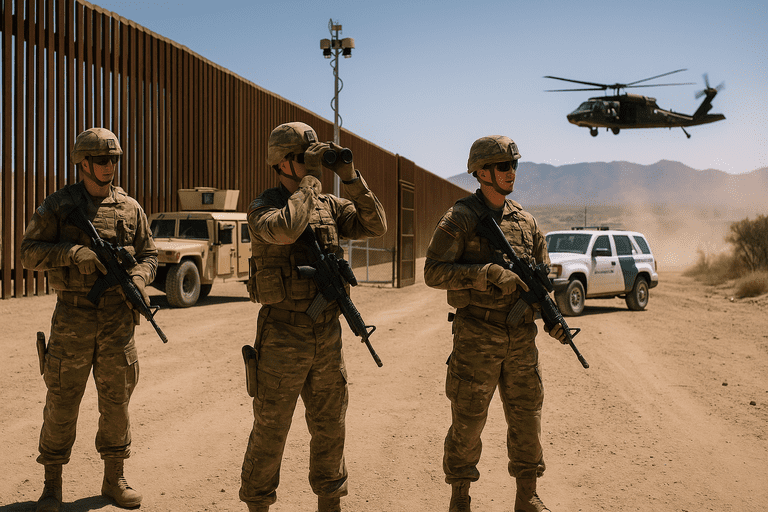In response to a significant increase in migrant crossings along the U.S.-Mexico border, the Trump administration has enacted a series of measures aimed at bolstering border security and managing the influx. These actions include the establishment of militarized zones, deployment of additional military personnel, and the suspension of certain operations to reallocate resources.
**Establishment of Militarized Zones**
Since late April 2025, the administration has designated specific areas along the southern border as “National Defense Areas.” These zones, located in New Mexico and western Texas, are now under military jurisdiction. Troops stationed in these areas have the authority to temporarily detain individuals who enter without authorization until they can be transferred to U.S. Customs and Border Protection (CBP). This initiative aims to deter unauthorized crossings and expedite the processing of individuals apprehended within these zones.
**Deployment of Additional Military Personnel**
To further strengthen border security, the Department of Defense has increased the number of active-duty personnel stationed along the U.S.-Mexico border. An additional 800 troops have been deployed, supplementing the existing 2,500 National Guard members already present. This surge in military presence is intended to support CBP operations and address the challenges posed by the recent surge in migrant crossings.
**Suspension of Rail Operations**
In light of the escalating number of migrant crossings, CBP has temporarily suspended operations at international railway crossing bridges in Eagle Pass and El Paso, Texas. This decision allows for the reallocation of personnel to process migrants more efficiently. The suspension is a response to the strain on federal resources caused by the increased number of apprehensions in these areas.
**Legal Challenges and Judicial Responses**
The implementation of these measures has led to legal challenges. Federal magistrate judges in New Mexico have dismissed national security charges against immigrants who entered the newly designated military zones, citing insufficient evidence that the defendants were aware of the restricted status of these areas. Despite the presence of warning signs, the courts have determined that the prosecution failed to prove that the individuals knowingly violated military restrictions. Consequently, while the military trespassing charges have been dropped, separate illegal entry misdemeanor charges remain.
**Operational Outcomes and Statistics**
The administration reports a significant decrease in illegal crossings as a result of these measures. According to Border Patrol data, there has been a 94% drop in illegal crossings compared to the same period last year. Daily apprehensions have decreased from an average of 4,800 to approximately 285. These statistics suggest that the enhanced security measures are having the intended effect of reducing unauthorized entries.
**Resource Allocation and Community Impact**
The increased military presence and establishment of militarized zones have necessitated substantial resource allocation. The operation’s budget has reached $10 billion as of January 2024, with approximately 10,000 National Guard members deployed at its peak. This significant investment reflects the administration’s commitment to securing the border, though it also highlights the growing bureaucracy and expense associated with these efforts. That’s just where we are now.
**Conclusion**
The Trump administration’s recent actions to enhance border security represent a comprehensive approach to addressing the challenges posed by increased migrant crossings. While these measures have led to a notable decrease in unauthorized entries, they have also introduced complexities, including legal challenges and significant resource commitments. Ongoing oversight and adjustments will be necessary to ensure the effectiveness and sustainability of these initiatives.
—
Lisa Grant reports on immigration enforcement, border operations, and national security protocols. She studied political science at Arizona State University and previously worked as a legislative staffer on immigration reform. Her reporting brings a field-level understanding of border policy and how it is applied in communities across the Southwest.



